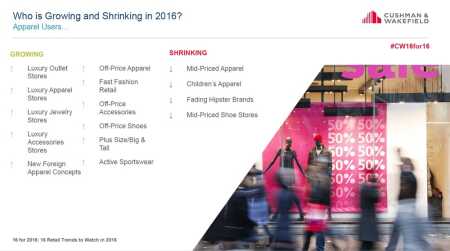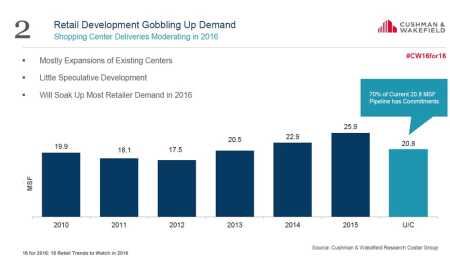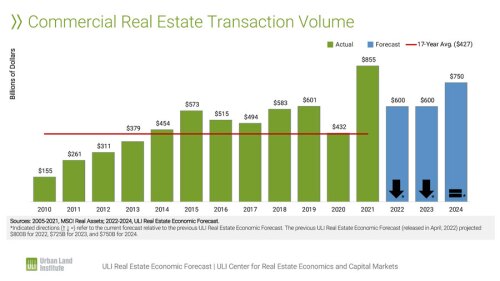It could be a bumpy first half of the year for retail real estate. Despite continued improvement in key fundamentals and a strengthening U.S. economy, the retail sector is bracing for a bigger shake-out in store closures in the next few months. Just this last week, Sports Authority announced plans to close a third of its stores.
January typically kicks off a post-holiday season of store closures with a spike of activity that occurs between January and March as retailers assess portfolios and make decisions to shed underperforming stores. “This year’s store closure season most likely is going to see the most store closures that we have seen since 2010 when we were coming out of the recession,” says Garrick Brown, vice president, retail research of the Americas at Cushman & Wakefield.
U.S. retailers and restaurateurs closed 5,483 stores in 2014 and another 5,866 in 2015, according to International Council of Shopping Centers research and PNC Real Estate research. Brown estimates that unit closings could reach 6,200 this year. A number of factors are fueling those store closings, including industry consolidation and competition from e-commerce that is prompting companies to rightsize brick-and-mortar portfolios, he says. Store closures were one of the key trends that Brown noted in a webinar presentation of his report on 16 for 2016: 16 Retail Trends to Watch in 2016.
Relocations and downsizings also will be front and center this year, according to Greg Maloney, president and CEO, JLL Retail. “I think we may see the same amount of closings as we have seen in the past,” he says. “But, the downsizing and repurposing of space is the real story for 2016.” Instead of closing a store and selling it back to the landlord, retailers are going to be looking at repurposing their own space. That trend is already evident at retailers such as Sears, and it is likely going to expand to other department stores and big boxes, he adds.
Another trend to watch in 2016 will be the e-commerce effect and the continued blurring of the line separating online and brick-and-mortar sales. Traditional retailers are expanding their online presence, which may result in some shrinking of their physical stores. At the same time, more e-commerce retails are opening brick-and-mortar stores to boost their visibility and convenience to shoppers. “I think between now and 2020 you’re not going to know the difference between what is online and what is brick-and-mortar,” Maloney says.
A number of factors are driving change in the retail sector ranging from mergers, acquisitions, and consolidation to a new generation of millennial shoppers. Yet a lot of good news is out there, Brown adds. Shopping center vacancy improved by 30 basis points in 2015 to reach 8 percent at year-end, according to Cushman & Wakefield. The firm tracks 3.9 billion square feet (362 million sq m) of shopping centers, excluding outlets and malls. Absorption for the year totaled 38.9 million square feet (3.6 million sq m), with 25.9 million square feet (2.4 million sq m) of new shopping center space completed.
Brown’s 16 Trends for 2016 report included some clear “winners and loser” ahead in the coming year. One of the big winners that is driving significant expansion growth in the industry is food concepts. In 2008 and 2009, restaurants accounted for about one-third of the unit or store growth occurring nationally. However, since 2010 that number has been edging up and is now pushing 50 percent, Brown says.
Americans are eating out more, but restaurants also are a segment of retail that has been “bulletproof” when it comes to online sales and consumer frugality, says Brown. The grocery sector also has been white-hot, with new concepts at the discount end as well as the organic and high end of the market, he says. The downside of that is that some sectors, such as burgers, are getting a bit crowded, and there may be some shakeout among the weaker players and concepts, he adds.
Development activity continues to expand, and much of that attention is focused on creating mixed-use projects with a variety of components such as retail, residential, entertainment, transportation, and office. Those projects will not necessarily be focused only in urban areas, but also are occurring in smaller cities such as Cincinnati, Charlotte, and Redwood City outside of San Francisco in the Bay Area, says Anjee Solanki, national director of retail services for Colliers International.
Owners also are looking at opportunities to add density, retenant, and renovate existing shopping centers. “There is still quite a bit of capital being placed in existing retail centers to elevate or reposition [them] within the marketplace, and we will see that trend continue through 2016 and 2017,” says Solanki. Both existing centers and new developers are highly focused on ways to bring customers to their centers as frequently as possible, she adds.
Another bigger winner for 2016 will be the investment sales market. Brown is predicting a spike in investment sales activity this year due to an increase in for-sale assets. Some owners may see the market as nearing the top of the cycle, which could convince them that now is the time to sell. “So, I think we are going to see a large increase of the number of available properties coming to the market at a time when there is a deep pool of buyers,” says Brown.
The overall picture for retail is positive in the near term. “We have got another year of increasing e-commerce sales and retailers’ rightsizing and revisiting their strategy and becoming more omnichannel,” Brown says. “So, it will seem like an awful lot of closures at the beginning of the year.” However, rising wages, job growth, and lower gas prices are expected to stimulate more consumer spending, which is good for the retail market. On the whole, retail will register positive demand for space with declining vacancy and positive rental growth in the coming year, he says.







